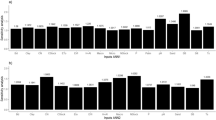Abstract
Forests are among the main places on Earth where carbon is collected and accumulated. However, instrumental assessment of carbon fluxes is possible only for small areas. When solving the scaling problem, machine learning methods are used, which allow transforming the Earth’s surface reflectance intensities in different spectral ranges into ground-based in situ observations. We suggest a regression neural network model of the multilayer perceptron type for assessment of carbon fluxes. The model is trained on FLUXNET network data for a station located in a boreal coniferous forest (56.4615° N, 32.9221° E). Using the vegetation indices NDVI and EVI measured by the MODIS spectroradiometer onboard the Aqua satellite, the air temperature at an altitude of 2 m, and total precipitation as input data, the model estimates the gross primary production (GPP), net ecosystem exchange (NEE), ecosystem respiration (TER), and some other parameters which characterize water and energy fluxes. The statistical assessments for the test dataset show high correlation coefficients (R) and Nash–Sutcliffe coefficients (NSE): R > 0.9 and NSE ≥ 0.87 for GPP and TER; R = 0.4 and NSE = 0.15 for NEE.




Similar content being viewed by others
REFERENCES
D. Baldocchi, E. Falge, L. Gu, R. Olson, D. Hollinger, S. Running, P. Anthoni, Ch. Bernhofer, K. Davis, R. Evans, J. Fuentes, A. Goldstein, G. Katul, B. Law, X. Lee, Y. Malhi, T. Meyers, W. Munger, W. Oechel, U. K. T. Paw, K. Pilegaard, H. P. Schmid, R. Valentini, S. Verma, T. Vesala, K. Wilson, and S. Wofsy, “FLUXNE-T: A new tool to study the temporal and spatial variability of ecosystem-scale carbon dioxide, water vapor, and energy flux densities,” Bull. Am. Meteorol. Soc. 82 (11), 2415–2434 (2001).
K. G. Gribanov, R. Imasu, and V. I. Zakharov, “Neural networks for CO2 profile retrieval from the data of GOSA-T/TANSO-FTS,” Atmos. Ocean. Opt. 23 (1), 42–47 (2010).
D. Rolnick, P. L. Donti, L. H. Kaack, K. Kochanski, A. Lacoste, K. Sankaran, Ross A. Slavin, N. Milojevic-Dupont, N. Jaques, A. Waldman-Brown, A. Luccioni, T. Maharaj, E. D. Sherwin, S. Karthik Mukkavilli, K. P. Kording, C. Gomes, A. Y. Ng, D. Hassabis, J. C. Platt, F. Creutzig, J. Chayes, and Y. Bengio, “Tackling climate change with machine learning,” ACM Computing Surveys (CSUR) 55 (2), 1–96 (2022).
P. D. Heermann and N. Khazenie, “Classification of multispectral remote sensing data using a back-propagation neural network,” IEEE Trans. Geosci. Remote Sens. 30 (1), 81–88 (1992).
M. Cao, S. Marshall, and K. Gregson, “Global carbon exchange and methane emissions from natural wetlands: Application of a process-based model,” J. Geophys. Res.: Atmos. 101 (D9), 14 399–14 414 (1996).
X. Dou, Y. Yang, and J. Luo, “Estimating forest carbon fluxes using machine learning techniques based on eddy covariance measurements,” Sustainability 10 (1), 203 (2018).
T. Yu, Q. Zhang, and R. Sun, “Comparison of machine learning methods to up-scale gross primary production,” Remote Sens. 13 (13), 2448 (2021).
A. V. Polyakov, “The method of artificial neural networks in retrieving vertical profiles of atmospheric parameters,” Atmos. Ocean. Opt. 27 (3), 247–252 (2014).
J. Zeng, T. Matsunaga, Z.-H. Tan, N. Saigusa, T. Shirai, Y. Tang, S. Peng, and Y. Fukuda, “Global terrestrial carbon fluxes of 1999–2019 estimated by upscaling eddy covariance data with a random forest,” Sci. Data 7 (1), 1–11 (2020).
G. Tramontana, M. Jung, C. R. Schwalm, K. Ichii, G. Camps-Valls, B. Raduly, M. Reichstein, M. A. Arain, A. Cescatti, G. Kiely, L. Merbold, P. Serrano-Ortiz, S. Sickert, S. Wolf, and D. Papale, “Predicting carbon dioxide and energy fluxes across global FLUXNET sites with regression algorithms,” Biogeosciences, No. 13, 4291–4313 (2016).
J. Kurbatova, C. Li, A. Varlagin, X. **ao, and N. Vygodskaya, “Modeling carbon dynamics in two adjacent spruce forests with different soil conditions in Russia,” Biogeosciences 5 (4), 969–980 (2008).
W. Zhengxing, L. Chuang, and H. Alfredo, “From AVHRR-NDVI to MODIS-EVI: Advances in vegetation index research,” Acta Ecologica Sinica 23 (5), 979–987 (2003).
ORNL DAAC 2018. MODIS and VIIRS Land Products Global Subsetting and Visualization Tool. ORNL DAAC, Oak Ridge, Tennessee, USA. Cited February, 2022. https://doi.org/10.3334/ORNLDAAC/1379
NASA Earth Data Portal. https://ladsweb.modaps.eosdis. nasa.gov/missions-and-measurements/modis/. Cited July 25, 2022.
ECMWF Copernicus Climate Change Data Service. https://cds.climate.copernicus.eu/cdsapp#!/dataset/ reanalysis-era5-land?tab=form. Cited July 25, 2022.
D. Baldocchi, B. Hicks, and T. Meyers, “Measuring biosphere-atmosphere exchanges of biologically related gases with micrometeorological methods,” Ecology 69, 1331–1340 (1988).
H. P. Schmid, “Source areas for scalars and scalar fluxes,” Bound.-Lay. Meteorol. 67, 293–318 (1994).
D. E. Reichle, The Global Carbon Cycle and Climate Change: Scaling Ecological Energetics from Organism to the Biosphere (Elsevier, 2020), pp. 150–152. https://doi.org/10.1016/C2019-0-01382-9
J. E. Nash and J. V. Sutcliffe, “River flow forecasting through conceptual models. Part I—A discussion of principles,” J. Hydrol. 10 (3), 282–290 (1970).
L. Bottou, “Large-scale machine learning with stochastic gradient descent,” Proc. COMPSTAT'2010 (2010), pp. 177–186.
A. Paszke, S. Gross, F. Massa, A. Lerer, J. Bradbury, G. Chanan, T. Killeen, Z. Lin, N. Gimelshein, L. Antiga, A. Desmaison, A. Kopf, E. Yang, Z. DeVito, M. Raison, A. Tejani, S. Chilamkurthy, B. Steiner, L. Fang, J. Bai, and S. Chintala, “PyTorch: an imperative style, high-performance deep learning library,” Adv. Neural Inform. Proces. Syst. 32, 8024–8035 (2019).
N. Huang, L. Wang, Y. Zhang, S. Gao, and Z. Niu, “Estimating the net ecosystem exchange at global FLUXNET sites using a random forest model,” IEEE J. Sel. Top. Appl. Earth Observ. Remote Sens. 14, 9826–9836 (2021). https://doi.org/10.1109/JSTARS.2021.3114190
Funding
The work was supported by the Ministry of Science Higher and Education of the Russian Federation (project no. FEUZ-2023-0023).
Author information
Authors and Affiliations
Corresponding authors
Ethics declarations
The authors declare that they have no conflict of interest.
Rights and permissions
About this article
Cite this article
Rozanov, A.P., Gribanov, K.G. A Neural Network Model for Estimating Carbon Fluxes in Forest Ecosystems from Remote Sensing Data. Atmos Ocean Opt 36, 323–328 (2023). https://doi.org/10.1134/S1024856023040152
Received:
Revised:
Accepted:
Published:
Issue Date:
DOI: https://doi.org/10.1134/S1024856023040152




